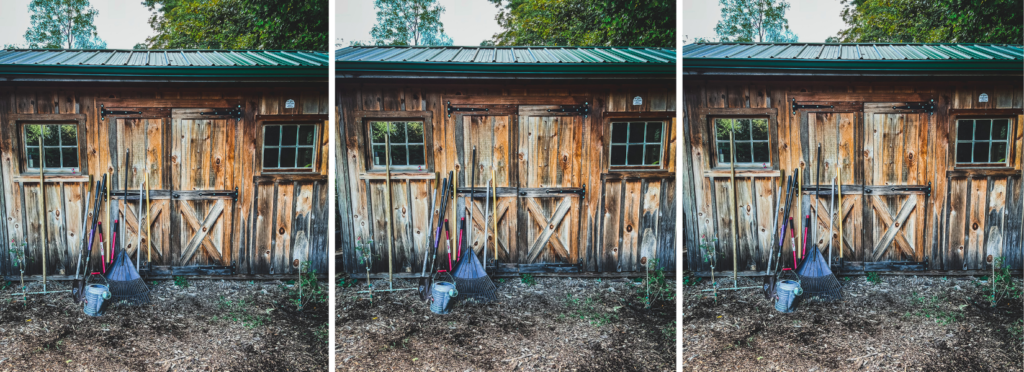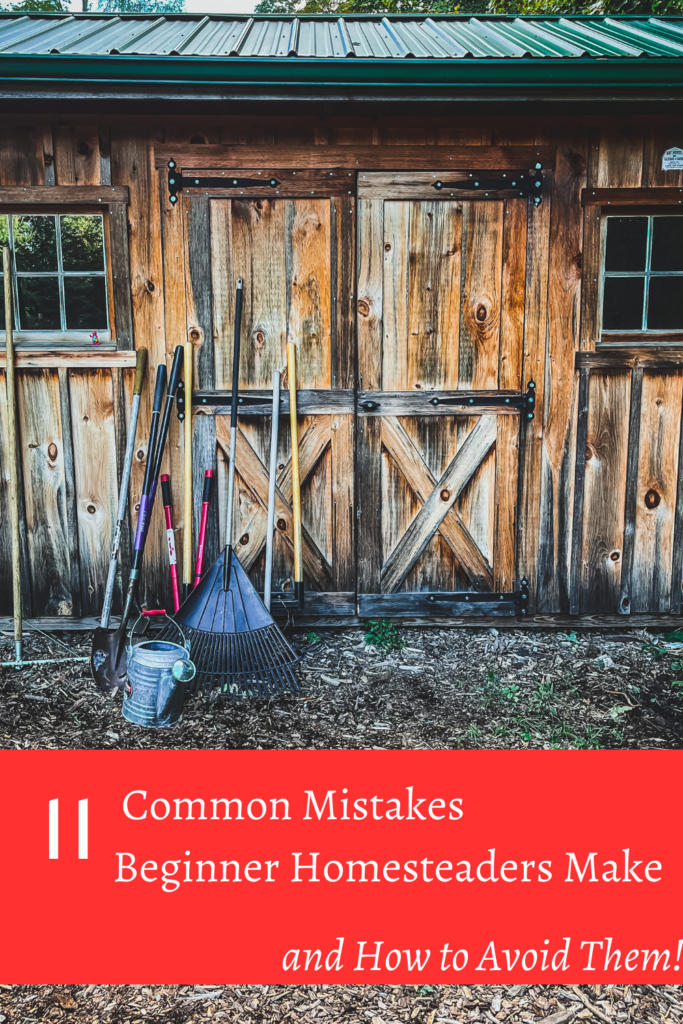
This post is all about the most common mistakes people tend to make as beginners when starting out with homesteading. Read on to learn how to avoid this list of 11 homesteading mistakes.
1. Starting Too Small
Want chickens? Cool, plan for sheep/goats/heck maybe even a mini jersey cow as well. 😉 The more you homestead, the more you’ll want to expand.
Start planning and dreaming BIG now so that you don’t have to go back and refigure your infrastructure/fencing/housing because it’s too small. Maybe you can’t afford the farm of your dreams right now, but maybe you can plan for it.
So in the meantime, consider utilizing mobile shelters, mobile waterers, existing infrastructure, temporary fencing (aka electric fencing/netting), and the like so that you don’t “settle” for a permanent structure that’s not truly ideal for your land or your future plans.
Leave space for those big dreams!
2. Going Too Big with Your Garden Planting
Contrasting number one with this: plan for a big garden space, BUT don’t go too big your first year.
Have 5000 square feet fenced off from deer? Cool.
Take a 10×10 corner and learn how to grow a few staples first – trust me!
My biggest regret with my garden starting out was trying to grow too many things all at once. This left me with weeds and a ton of sad, failing crops.
3. Not Having a Plan
Take a bird’s eye view of your property. What are you working with? What’s your water/grazing space/sunlight/terrain like?
Think about choosing the animals and plants that would work best with YOUR land instead of jumping for the special things you always wanted but maybe won’t thrive where you are.
For example, I’d love to jump in with a milk cow but we have limited pasture and a lot of forbs (non-woody weeds) and woods. Rotationally grazing smaller ruminants that prefer this type of forage like sheep or goats (or even pigs, though they aren’t ruminants) FIRST is smarter so we can prep the land for future pasture.
Another example for you: we have a fenced orchard that grows tons and tons of forbs and is a pain to mow – insert orchard sheep and problem solved!
4. Housing Your Animals Too Far Away from Your Home
Our property is set up where our home is on a hill above a flat plain we call “the field.” In the field we have our garden, orchard, chickens (and coming soon: sheep).
It’s a bit of a hike down there and if it were possible to set up a zip line or something I would haha because for the multiple trips we make a day to our chickens to feed/water/unlock/lock
up/check for eggs, etc, it’d be great if it were just a TAD bit closer.
Know this going in – think about your walking paths, your work spaces, your chores. Arrange your homestead infrastructure in a way that saves you time and energy.
Because even if that morning walk through the fields sounds super dreamy, one day when you have a predator attack or realized at 9PM that you forgot to close up your chickens you’ll wish you were closer!
One thing we did well was keep everything close to our working hub. The garden shed is also the feed storage room and it backs up to the chicken area and is across from the garden gate, adjacent to the orchard, and across the path from the greenhouse.
Just like when you plan a kitchen renovation – consider your steps!
5. Limiting Your Thinking to Only “What Is”
Your land may not have water access but have you considered drilling a manual or electric pump well? Cutting swales? Digging a pond? Rain water catchment?
There are many many ways to work with what you’ve got.
Same for the example I shared above about the cow. “We just have acres and acres of woods! We couldn’t possibly have a milk cow one day” has turned into “well, we can shape our landscape with animals that we can also use for meat/wool/milk/etc to prepare for a cow one day.”
Thinking outside the box happened for me when I dove in and learned more about different homestead animal besides the ones I was dreaming of.
6. Not Considering Fencing First
Whether for keeping things out (deer, predators, zombies lol) or in (Livestock guardian dogs, sheep, goats, chickens – you can totally free range chickens but remember they will LOVE to eat your garden and poop all over everything you sit on/touch) it’s essential!
We have 6’ high deer fencing for our garden, large chicken ranging area, and orchard but we unfortunately don’t yet have a perimeter fence for our 25 acres or even for the smaller acreage that we currently farm/protect with our LGD.
For our sheep and LGD we will be using electric netting until we can install a proper perimeter fence. This is very helpful in the beginning if you’re unsure of where you want your permanent fencing. We get all our electrical fencing supplies from Premier 1.
Make sure you consider installing fencing concurrently with your projects. It doesn’t have to cost much – we used cedar posts from our land and 6’ tall chicken wire for our orchard and garden.
7. Expecting Your Pet Dog or Random Breed Farm Dog to Be Your Livestock Guardian
We knew from experience that our lab/terrier mixes were NOT going to cut it for guardians for our flock.
LGDs (livestock guardian dogs) have been bred for centuries to protect and care for livestock and that’s not something you can train into a breed like our dogs who were bred to be bird (hunting) dogs.
Our search landed on a Great Pyrenees and though she’s still young, she’s an incredible protector for our kids and our animals.
Note that these animals come with a lot of specific character traits and I’d advise you to do your research before adopting them. Besides being HUGE, they are very independent minded.
8. Assuming Vermin Won’t Be a Problem for You
This post may contain affiliate links, which means I’ll receive a commission if you purchase through my links, at no extra cost to you. Please read full disclosure for more information.
Speaking of guardian animals, consider some barn cats ASAP! Raise them alongside your chickens, keep them near the feed shed. Feeding grain to poultry will most likely eventually result in mice and rats, no matter how hard you wish them away, trust me!
Keeping some good mousers around will help tremendously to prevent a problem before you have one. We have house cats but I so wish I could go back in time and add barn cats when we got our first chickens!
Rat problems suck and cost you money. That being said, the best investment I made for this problem was the Ratinator Rat Trap. I wasted a good amount of money on other traps before I found this one – it’s worth it’s weight in gold!
9. Not Prepping for Your Animals
I tell my kids often that there isn’t a chicken doctor around, so we need to be extra careful when we handle them. If something happens, it’s on us to help them, or, they most likely won’t make it.
It made the most sense to us, since we are raising organically-fed, ultra clean poultry/eggs to focus on natural remedies.
So we are stocked up on all the natural necessities for preventative concerns to acute injury treatment. In a way, you need to prep for your animals like you prep for your family. Do you have on hand what you’d need for XYZ emergency?
Check out my list of homestead must-haves here.
10. Ignoring New Expenses
We all homestead, garden, and raise animals for food to save money, create self sufficiency, and control the quality of the food we eat. But it all tends to come with some (if not a lot) of up-front costs.
When we finally made the mindset switch to “hey we legit have a farmstead now, let’s budget for it”, finding the funding for our projects became a lot easier than draining our personal budget.
Allocating money to the projects and supplies needed and planning for coming expenses changed the game for our financial planning and also the way we felt about the expenses/growth our our homestead.
Instead of it feeling like a financial burden, allocating specific funds to BUILD our homestead and GROW toward our self sufficiency goals allowed us to do so with peace, excitement, and hope.
Even if that means saving $20 a week (by baking your own bread for example!) so that you have an extra $80-$100 per month to INVEST in your homesteading future, that adds up.
If funds are tight, find a few ways to make money from your homestead (sell eggs, grow extra veggies to sell, plant a wildflower garden and sell bouquets at the end of your driveway, etc) and start setting that aside in a fund that ONLY pays for homestead investments and Not personal household needs/wants.
If you have more resources but need that mindset shift to give yourself permission to spend, try giving your homestead a monthly budget and stick to it. That way you know you have a set amount of money to invest and you won’t feel guilty doing so, nor will you go crazy overboard each month because you have that number to stick to.
We have a big expense coming up – fencing. So each month I have allocated a portion of our homestead budget to SAVE for that expense. This way, we don’t over do it on projects of lesser importance in the mean time, nor do we cringe with dread on fence install day when it’s time to pay for the materials.
PS: If you’re looking for a helpful budgeting program, check out Every Dollar!
11. Shopping for Animals Before Apples
Order your fruit trees before you order those chicks!
Plan and plant your orchard as soon as you can. Why? It can take 2-5 years before a fruit tree harvest, depending on what size trees you plant, the spring weather, your soil, and if you made sure to plant companion trees for cross pollination!
BONUS: Overthinking All the Things
Our way may be flawed, but we are definitely the ready fire aim type people!
We absolutely think and plan, but we tend to dive in and learn by doing and that has seemed to move the dial further toward our dreams than anything else.
I’m a huge proponent of just DOING. Taking action, moving forward – whether it’s doing research or just going ahead and buying that dang milk cow! Ha!
If you’re like me and ‘re like me and prefer to have hard copy resources on hand, check out The Self-Sufficient Backyard book. It has a TON of great ideas to help you get started homesteading, step by step.
Just beware that you don’t spend too much time dwelling on the what if’s and the worries. The confidence will come from doing. You got this!


